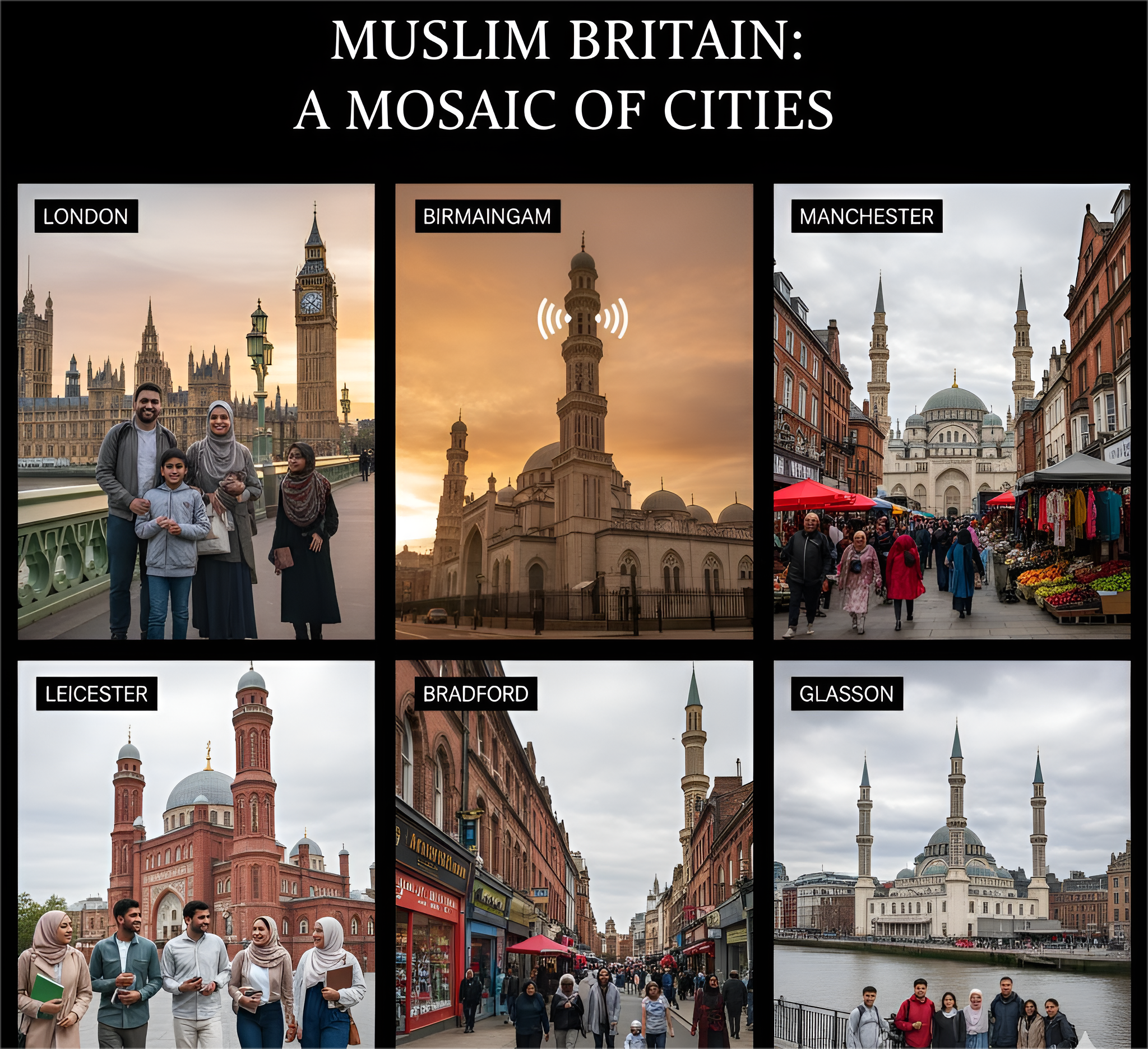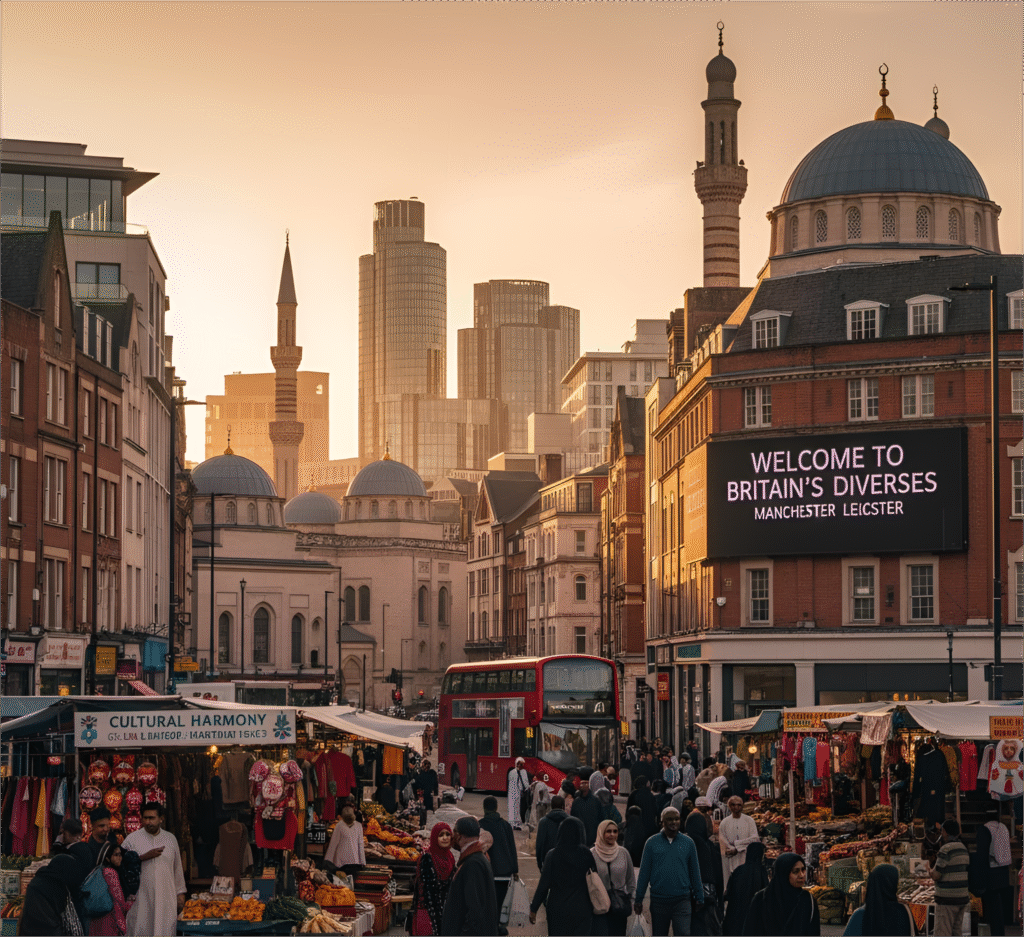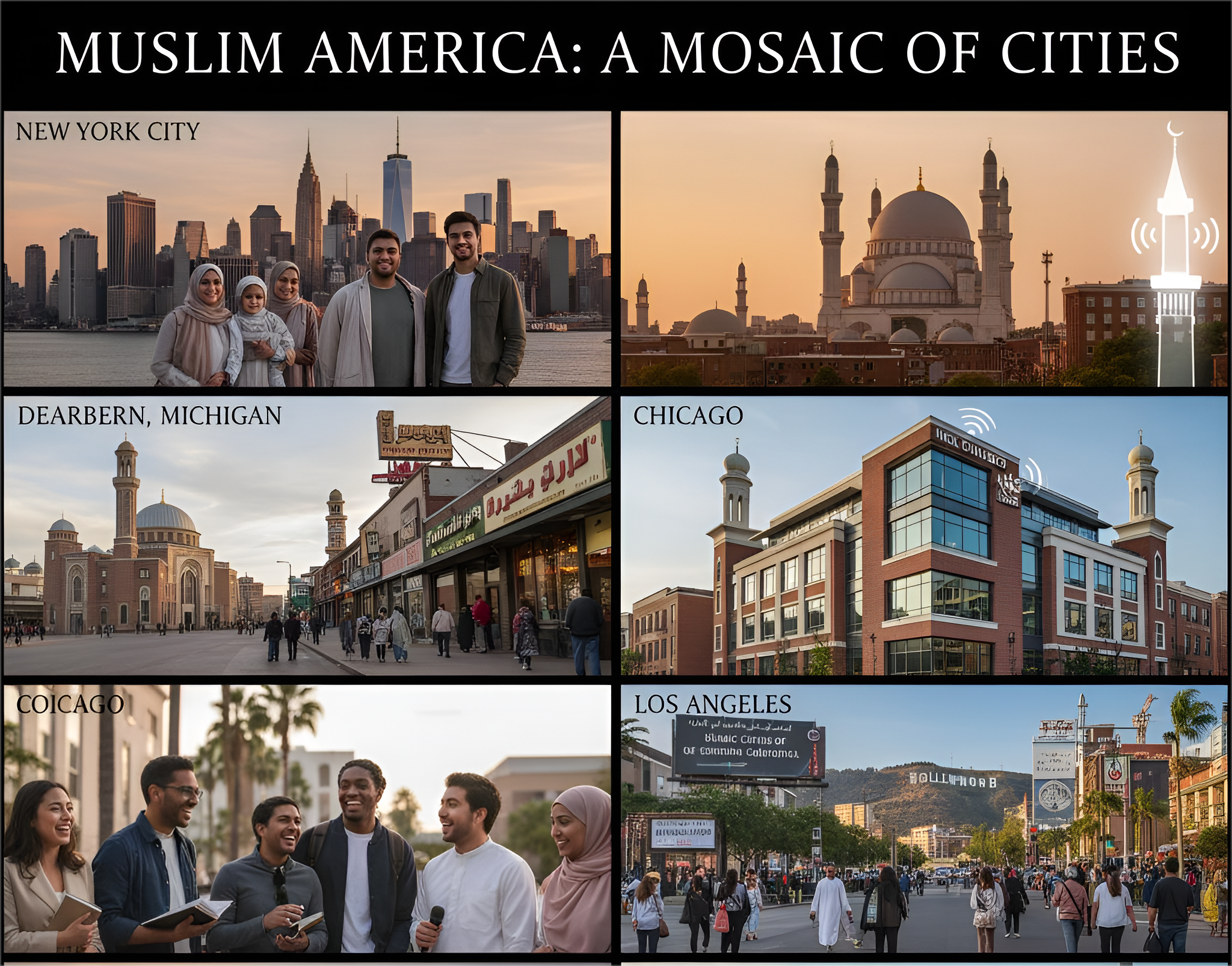UK cities with highest Muslim Population

The Lasting Legacy and Lively Future of British Islam: A Story of Five Cities
Within the vibrant and constantly changing fabric of contemporary Britain, the images of Islamic religion and tradition are inextricably embedded in the metropolises themselves. Muslim communities have not just developed a large and influential presence within the United Kingdom for many decades but have also become an integral part of the social, cultural, and economic vitality of its cities. This piece goes to the core of British Islam with a look at five major urban areas with the highest concentrations of Muslims: London, Birmingham, Bradford, Manchester, and Leicester. By looking at their distinctive histories, population profiles, cultural icons, and the countless contributions and challenges of their Muslim residents, a rich tale of adaptation, tenacity, and lasting influence is revealed.
The history of Muslims in Britain is not homogeneous. It is a rich tapestry of varied communities from South Asia, the Middle East, Africa, and other parts of the world, each with its own traditions, languages, and way of looking at the world. From the curry houses of Brick Lane to the cotton mills of the North, and from the majestic mosques that rise above cityscapes to the drive that powers local economies, the impact of these communities cannot be denied. This tour of five major cities is an insight into British Muslims’ lived lives, embracing their successes and recognising the struggle against prejudice and for further social inclusion.
London: A Global Hub of Islamic Diversity
As Britain’s vast and cosmopolitan capital, it is no wonder that London contains Britain’s biggest and most multicultural Muslim population. More than 1.3 million Muslims call Greater London home, comprising 15% of the city’s population according to the 2021 census. The diverse and dynamic community is a mini-ummah in itself, with large cohorts of Pakistani, Bangladeshi, Somali, Turkish, Nigerian, and Arab heritage, together with a sizeable proportion of converts.
The Muslim presence in London dates back to the Elizabethan period. But large-scale settlement followed in the post-war period, with the need for labour attracting men from all over the Commonwealth. The East End of London, and in particular Tower Hamlets borough, was a concentration point for the new Bangladeshi community, many of whom were employed in the textile and clothing trades. Today, this district is still a thriving heartland of British Bangladeshi culture, with the legendary Brick Lane standing as witness to their lasting legacy.
The face of London’s architecture is punctuated by breathtaking mosques that function as spiritual and community centers. The East London Mosque, with its gleaming golden dome and accompanying London Muslim Centre and Maryam Centre, is one of Europe’s largest Islamic centers, providing a wide range of services in addition to daily prayers, such as educational courses, social welfare services, and interfaith discussion. The Regent’s Park Mosque, or London Central Mosque, is another obvious landmark, its imposing structure a testament to the established status of Islam in the capital.
The cultural achievements of London Muslim communities are vast. From the colorful street markets of Whitechapel and the food of Southall and Wembley, to the artists, musicians, and writers who live in the city and have an influence on all aspects of London life, their presence is felt in every aspect of life in London. The annual Eid in the Square festival, held in Trafalgar Square, is a reflection of the community’s integration into the city’s civic life, attracting thousands of Londoners from all walks of life to come together to celebrate.
But life in London for Muslims is not all smooth. The ghost of Islamophobia hangs over the community, and hate crimes and discrimination are facts of life for many. Poverty, overcrowding, and education levels also disproportionately target some Muslim communities, especially the more deprived boroughs. In the face of these obstacles, however, the adaptability and resilience of London’s Muslim community continue to define the city as a genuinely global and multicultural capital.
Birmingham: The Heart of British Kashmiri and Diverse Muslim Life
Birmingham, the second-largest city in the UK, has a strong and diverse Muslim community that has made its contemporary identity what it is today. The 2021 census found that approximately 30% of Birmingham residents self-identify as Muslim, which makes it one of the most important Islamic centers in the nation. Although the city has a broad range of Muslim groups, it is perhaps best known for its large and well-established Kashmiri community from the Azad Kashmir’s Mirpur district.
The history of Muslims in Birmingham is closely linked with the industrialized past of the city. After the Second World War, Birmingham’s manufacturing sector was severely short of labor, which led to mass recruitment from the Commonwealth. Most of the early Muslim settlers were solitary men who traveled to the factories and foundries to work and eventually return home. They were, however, accompanied by their families when they settled down, and it is these that formed the prosperous communities seen today.
Perhaps the most visible symbol of Muslim presence in Birmingham is the Birmingham Central Mosque in the Highgate district. Opened in 1975, it is one of the biggest mosques in Western Europe and a central religious and social centre for Birmingham’s multicultural Muslim community. The Green Lane Masjid, once a public library and baths, is another important institution, recognized for its far-reaching community outreach and educational initiatives.
Birmingham’s Muslim communities’ entrepreneurial spirit has made a revolutionary contribution to the economy of the city. The “Balti Triangle,” located in the Sparkbrook, Balsall Heath, and Moseley districts, was a culinary phenomenon in the 1980s and 90s and created a new style of curry that became identified with the city. Outside the food sector, Muslim businesses are common in retail, transport, and many other areas, helping to fuel local jobs and economic development.
In spite of their long history in the city, Birmingham’s Muslim populations have not been without their problems. The “Trojan Horse” controversy in 2014, a highly contentious and widely contested claim of a conspiracy by hard-line Muslims to seize control of several of the city’s schools, led to a long shadow over the community and put pressure on community relations. Social deprivation and educational disadvantage also remain issues in some of the city’s most Muslim-occupied areas. Yet, through a vibrant network of community organizations and the perseverance of interfaith dialogue, Birmingham’s Muslims are striving towards a more just and inclusive future.
Bradford: A City Formed by its Pakistani Heritage
Bradford, in the center of West Yorkshire, has a distinctive and well-established affiliation with the worldwide Muslim community, specifically from Pakistan. The census of 2021 reported that more than a quarter of Bradford’s population is Muslim, and the overwhelming majority is from the Mirpur district of Azad Kashmir. This common origin has forged an unbreakable bond of community and has had a lasting impact on the cultural and social milieu of the city.
The history of Muslim settlement in Bradford is necessarily tied to the city’s former prosperous textile industry. During the mid-20th century, Bradford’s wool mills cried out for labor, and recruitment drives in Pakistan generated a mass wave of migration. These initial trailblazers, working long hours in difficult circumstances, opened the way for their relatives to follow, building a thriving and tenacious community in the very center of the industrial North.
The Bradford Council for Mosques, set up in 1981, testifies to the organizational ability of the community and its devotion to collective effort. It is an umbrella body that speaks for more than 140 mosques and Islamic establishments in the district, contributing to leadership, lobbying, and social welfare in the community. There are many exquisite and purpose-designed mosques in the city, which are key sites for worship, education, and community activity.
The cultural tapestry of Bradford is densely woven with the practices of its Muslim populations. The Eid Mela of the city is a popular festival of music, food, and culture that draws visitors from throughout the region. Pakistani cuisine is present everywhere, with a wide variety of restaurants and takeaways that serve true and tasty cuisine. The city has also given birth to a number of high-profile British Muslim politicians, artists, and academics, who have contributed to the national debate in important ways.
Nonetheless, Bradford has also been gripped by major social problems regarding social cohesion and economic poverty. The city witnessed serious riots in 2001, which revealed underlying tensions between white and South Asian communities. Although a lot of work has been done in the intervening years to address problems of community relations, the city still struggles with segregation, poverty, and educational underachievement in many of its poorest neighborhoods. Notwithstanding these issues, however, the resilience and strong sense of community among Bradford’s Muslims remains one of the defining characteristics of this special British city.
Manchester: A Northern Powerhouse of Islamic Life

Manchester, the city of industrial fame and rich cultural diversity, also boasts a significant and thriving Muslim population. The census of 2021 found that more than 12% of the city’s population is Muslim, with a considerable number of Pakistani origin, among a rich diversity of other communities from the Middle East and Africa.
The earliest history of Muslims in Manchester goes back to the late 19th century when Yemeni sailors came to the port town of Salford. But, as in other northern towns, it was the post-war mass migration, prompted by the need for workers in the manufacturing and textile industries, that brought the largest number of Muslims. The creation of the Manchester Central Mosque in the 1950s, which started off in a terraced house, was a major turning point in the community.
The Manchester Central Mosque, which is now a massive and imposing purpose-built mosque, is a symbol of the community’s growth and vigor today. The city is also proud to boast the “Curry Mile” in Rusholme, a popular road lined with South Asian restaurants, takeaways, and stores, now a renowned dining destination. The existence of institutions such as the Pakistani Resource Centre is indicative of the community’s determination to offer assistance and advocacy to its constituents.
The economic contribution of Manchester’s Muslim communities is significant. From the vibrant shop-lined Curry Mile to the wide range of Muslim-owned businesses in retail, transport, and the professions, their entrepreneurial spirit is an important part of the city’s economic vitality. The community is also politically active, with increasing numbers of British Muslims serving their constituents in local and national government.
The Manchester Arena bombing in 2017, a vile act of terrorism perpetrated by someone of Libyan origin, was a traumatic experience for the city and Muslim people as a whole. Following the attack, there was a huge outpouring of solidarity and unity from all communities, with Muslim leaders and groups condemning the atrocities in strong terms and attempting to create bridges of understanding. The continued need to combat extremism and Islamophobia continues to be a top priority for the city and its multicultural community.
Leicester: A Model of Interfaith Harmony
Leicester, an East Midlands city, is frequently cited as being a model of interfaith relations and multiculturalism in Britain. The census in 2021 revealed that more than 18% of Leicester’s population is Muslim, and that it includes a significant and powerful Gujarati Muslim community. This community, whose members came to the UK in the 1970s after being driven out of Uganda by Idi Amin, has been a force that transformed the economic and social life of the city.
The Gujarati Muslim tale of Leicester is one of compelling resilience and business achievement. With little, they arrived in the UK and soon found themselves in the heart of Leicester’s textile and hosiery businesses, later venturing into retailing and other industries. Their tight-knit community connections and high work ethic facilitated them in developing thriving ventures, which have played an essential role in propelling Leicester’s economic growth.
Leicester has a variety of picturesque and vibrant Islamic centers and mosques, which provide the religious and social needs of Leicester’s multicultural Muslim community. The city’s interfaith relations are especially robust, with centuries-long experience of working together and respecting one another between the Muslim, Hindu, Sikh, and Christian communities. The Leicester Council of Faiths is a proactive and powerful organization that seeks to facilitate understanding and coordination between the city’s religious groups.
The cultural heritage of Leicester is a diverse brocade of various traditions, and Muslim people’s input is part of the whole. Leicester’s Belgrave Road, or the “Golden Mile,” is a lively center of South Asian culture, a kaleidoscope of shops, restaurants, and events. Leicester’s Eid festival is a festive and welcoming occasion, bringing people together from all walks of life to share in the celebrations.
Although Leicester has been cited as a model of successful integration, it is not entirely free of the problems that trouble other UK cities. Social deprivation and educational disadvantage remain an issue in some communities, and the community has to continue to stand guard against the scourge of prejudice and division. Nevertheless, the solid foundations of mutual respect and understanding that have developed in Leicester are a great example for other cities to follow.
Conclusion: A Shared Future
The histories of London, Birmingham, Bradford, Manchester, and Leicester provide a rich insight into the complex character of British Islam. They are histories of immigration and settlement, of adversity and achievement, and of the continued strength of faith and community. The Muslim communities of these cities have not just contributed to the cultural and social richness of their new homes but have also become a necessary ingredient in their economic and civic wellbeing.
As the UK continues to navigate the complexities of a rapidly changing world, the contributions of its Muslim communities will be more important than ever. By adopting diversity, inclusion, and respect for one another, and by standing together to address the common issues of poverty, inequality, and prejudice, the UK cities can create a future in which every single one of their citizens, no matter what their faith or background, has the potential to succeed. The cosmopolitan and dynamic Muslim populations of London, Birmingham, Bradford, Manchester, and Leicester are not only a product of contemporary Britain but a key factor in the making of its future.
For more like this visit : Hilalinfohub

Post Comment